Princes with Personality: From Prince Charming to Flynn Rider
Princes aren't what they used to be, and that's a good thing.
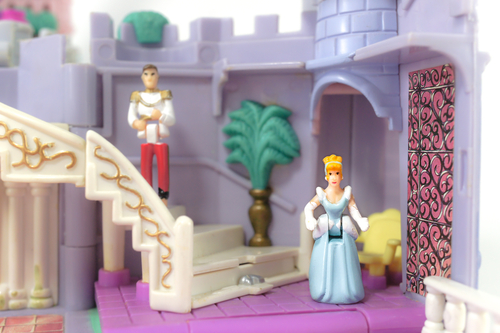

(via Shutterstock)
Disney Princesses are everywhere. From Internet quizzes asking which princess you “are” to reinterpretations of various princesses as cats, dudes, differently sized ladies, and older versions of themselves, we have a lot of exposure to princesses, especially the Disney ones. There are lots of articles about the princesses and how their appearances, vocal styles, and personalities reflected the times in which they were created. (Snow White’s voice was a singing style popular in the 1930s, but we like our princesses a little more pop/Broadway these days!)
But what about the princes? How have they changed from 1937’s Snow White and the Seven Dwarfs to more modern movies like 2010’s Tangled and 2013’s Frozen? Snow White’s Prince doesn’t even have a name. He’s just credited as “Prince,” while Rapunzel’s prince has two names: Flynn Rider and Eugene Fitzherbert. Snow White’s Prince is just there to be a prince and that’s all he needs to be, while Flynn/Eugene is bursting with identity, personality, and humor. As the roles of women have changed in society, the expectations for the role of “prince” have changed as well. Plus, as more women work in the entertainment industry, they are able to have greater influence on character and story development.
Before we get started, I want to mention that another TMS writer has done some excellent research on women in animation. I recommend that people check out Carrie Tupper’s “Women in Animation” series, parts one and two. She really fleshes out who the lady innovators and pioneers in animation were and are! Animation has been and still is a male-dominated field, but more and more women are working in the industry, as well as directing, writing, and other fields connected to creating these characters. I believe that this is one of the main reasons princes have had increasing amounts of personality over the years. Not all of the movies I’ll be referencing are Disney, but most are, mainly because Disney kind of has the lion’s share (be prepared!) of the animated movie industry. Let’s start at the beginning, shall we?
First, we have Snow White and the Seven Dwarfs, which was released in 1937. As much as it’s a lovely movie, especially for the time, Prince (the nameless prince who is nothing more than his profession of being a prince) has the personality of a cardboard box. Snow White herself isn’t much better; she frolics with forest animals, sings it out, and goes from princess to housemaid for seven very messy, workaholic dwarfs. The stereotype of woman-as-homemaker in need of a stable, working man was very much in play during this era in history, and Snow White and Prince reflect that. The most important thing he can do for her is elevate her from poverty and give her a stable marriage. It doesn’t seem to matter what he likes, if he’s funny, or what it is about him that she finds irresistible. Of course she likes him! He’s a prince!
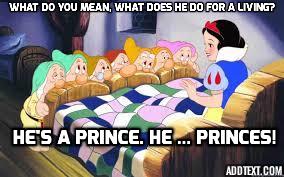
Princing ain’t easy.
In 1939, Fleischer Studios released Gulliver’s Travels, which features in part the love story of Princess Glory of Lilliput and Prince David of Blefuscu. Neither one of them had a lot of dialogue, but poor David basically had one spoken line in the whole thing, and that was his, “Wait here, Glory!” at about the 1:10:52 mark. I remember watching this as a kid, and loving it, but cracking up when the handsome prince’s spoken voice and singing voice were so completely unmatched. He sounds like he’s holding his nose! Maybe that’s why he only has one line? If you haven’t seen this delightfully weird classic, have a look:
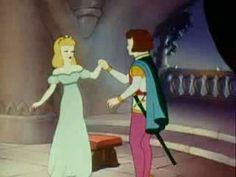
THOSE LEGGINGS THO.
Cinderella came out in 1950, and as animated movies became increasingly popular, studios put more and more effort into them, from the side characters to the main featured songs. According to the Disney wiki, Prince Charming was originally going to have a song of his own to sing, but that idea was abandoned. He was also supposed to have more scenes and dialogue, but those ideas were also replaced with different content. The straight-to-video sequels have given him more personality, but his original appearance was every bit as bland as Snow White’s prince, without even one song to sing.
Again, in the 1950s, women were supposed to want a good provider, and handsome was bonus. Poor Charming checked both boxes and we don’t get to know what exactly about him was so charming, besides his face and title. Just so you know, the wiki says there was an unused opening for Cinderella where the Prince chased a deer, but it turned out to be his friend and it was a game. It wasn’t just Cinderella who had a way with woodland creatures!
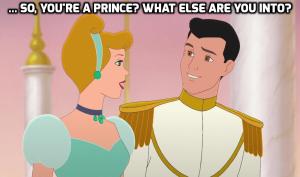
Venison, apparently.
When Sleeping Beauty was released in 1959, it was a stylistic departure from previous films. The animation looked different from Snow White and Cinderella, and was actually inspired by the look of medieval tapestries. The music was all adapted from Tchaikovsky’s classic Sleeping Beauty ballet, and lyrics were added to make the movie into a memorable Disney musical. But Sleeping Beauty was different in another way: it marked the first time we got a glimmer of personality from the prince. Prince Phillip had a name, a sense of humor, and integrity, making it somewhat apparent to the audience what it was that drew Aurora to this guy. They fell in love in the forest, and he was completely fine being stalked by her animal friends on their first date. He talked to his horse Samson every bit as much as Aurora talked to her forest friends. While Prince Charming and Cinderella sit around and stare at each other awkwardly, maybe Aurora and Phillip are on their honeymoon all like, “So, we need to build a massive birdhouse in the palace gardens, and a mansion-stable for Samson! And honey, did you invite the squirrels to our party?”
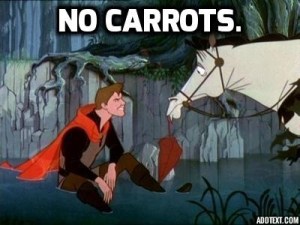
Dude. You dunked me when I needed to look dashing for a lady. No treats for you.
Flash forward to 1985, when Disney released The Black Cauldron, one of their lesser-known animated features. Based on Lloyd Alexander’s Prydain Chronicles, it’s the story of assistant pig-keeper Taran, Princess Eilonwy and their quest to destroy the Black Cauldron. This movie, although never one of Disney’s more popular features, is important for several reasons, not least because it is one of the first times a princess chooses a commoner “prince.”
Eilonwy and Taran’s romance is kid stuff—they’re too young to really be serious about anything—but Eilonwy rescues him at one point, and doesn’t need anything from him other than excellent companionship. This is a huge departure from form, one which started a trend that continues today in movies like Tangled and Frozen. One factor that may have something to do with this change is that more women were becoming involved in the creative process; Rosemary Anne Sisson, a British woman, wrote the screenplay for this movie. I’ve always liked The Black Cauldron, even if it got defeated in single combat at the box offices by the Care Bears. (It’s true. They used the stare. It’s real.)
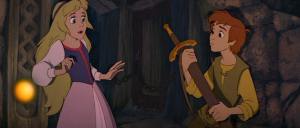
“Got the sword? Good. Let’s go bear hunting.”
This brings us to the beginning of the Disney Renaissance period, with The Little Mermaid in 1989, Beauty and the Beast in 1991, and Aladdin in 1992. None of these movies are perfect. Ariel gave up her family and voice for a guy, Belle and early-days Beast had a Stockholm vibe going on, and Aladdin had some issues with inappropriate lyrics (which were later replaced, but still). Nevertheless, there were some good things going on here as well.
Ariel and Eric shared a mutual love of music. Eric played his flute, danced, and obsessed over the singing voice of the woman who rescued him, while music was a huge part of Ariel’s life under the sea. She was a princess and he was a prince, so neither of them needed the other to elevate their status. Their relationship was at least based on honest attraction, even if Ariel should never have traded her ability to produce sound and be heard, and Eric had the gall to suggest that Ariel’s name might be Mildred. (Really, Eric, you animal-loving, affable flautist? Does she look like a Mildred?) Ariel’s infatuation might have been immature, but it was based on observation of his habits, interactions, and his decision to endanger his own life to rescue his dog Max.
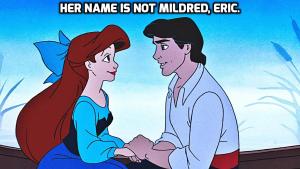
#notamildred
Belle and Beast had a rocky start. He was a snarling, feral temper with fur, and she was acting under duress to help her aging father. As they got to know each other, things changed. Beast began trying to find ways to make her happy, culminating in gifting Belle, the girl who wanted adventure in the “great wide somewhere” and always had her nose in a book, with a library of her own. He found out what Belle was about and worked to make her happy, even learning to read so he could share her passion. And, when it came time, Beast did not keep Belle from going home to care for her father.
Like Cinderella, Belle was not a princess, but what she lacked in social standing, she made up for with her independent streak, intelligence, and understanding. Marrying her prince turned Belle from a commoner into a princess, but there was never any doubt that Belle would have been all right if she had never married at all. She would have died single and happy before marrying Gaston.
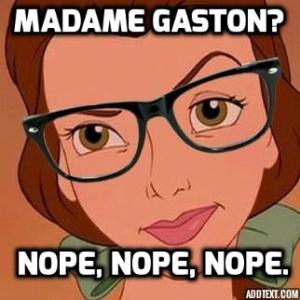
Spinsterhood is lookin’ good.
Jasmine and Aladdin are an interesting pair as well. This is one of the first examples of a princess falling for a commoner where both the princess and the commoner weren’t secretly royalty. Jasmine was already rich – she didn’t need to marry for money. Aladdin’s need to become “Prince Ali” was born of his own insecurity that a woman like Jasmine wouldn’t like the real version of him, and fear of the law that stated that the princess must marry a prince. Aladdin is the first Disney prince to marry into his royal status. In some ways he’s a dude version of Cinderella, going from poverty to royal consort by virtue of Jasmine choosing him and persuading the Sultan to change the laws. Not hurting matters: the fact that he was funny, cute, and had a flying carpet and an affinity for exotic pet ownership just like Jasmine…well, let’s hope that Rajah and Abu get along well!
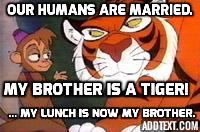
Play nice, kids.
In 1997, Fox Animation Studios released Anastasia, directed by former Disney employees Don Bluth and Gary Goldman. The premise of Anastasia is that the amnesiac Anya is actually the lost Russian princess Anastasia. There is more to the story than that, but where the story departs from the usual princess/prince tale is when she falls in love with Dimitri, a commoner, and chooses to give up her shot at a royal life. Her grandmother, finally convinced that Anya truly is her granddaughter, stresses to her that the life she chooses will not rob her of her family now that they have found each other. Having lived most of her remembered life as a commoner, Anastasia chooses to remain Anya and be with Dimitri. So, although Dimitri serves the role of love interest, and had the potential to have his status elevated via marriage to Princess Anastasia, the story bypasses royalty altogether.
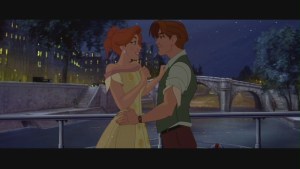
Just in time for the revolution of the proletariat.
By the end of the 1990’s, the themes of these American animated stories were far less about women choosing mates who would take care of them and much more about women choosing partners whom they considered interesting and attractive. That this coincided with the changing roles of women in the US during this time is no accident. The more likely women are to influence box office receipts and/or to be involved in the creative process, the more likely we are to get heartthrob princes with floppy hair we might want to play with, good senses of humor, and interesting hobbies of their own.
In Japan, Princess Mononoke was released in 1999, and gave us Prince Ashitaka and San (Princess Mononoke). Prince Ashitaka was less madly heroic and more dedicated to the protection of his people, and while he took an active role, San was the wilder of the two. Meanwhile, in America, Dreamworks’ 2001 hit Shrek gave us a prince who was an ogre and a reverse-Beauty and the Beast in Princess Fiona’s decision to embrace her own inner ogre and stay green for Shrek. Rather than the prince turning hot and human, we get Fiona saying that she’d rather be comfortable in her green skin than be miserable in her human one. Shrek is definitely the least stereotypically attractive prince, but Fiona loves him as he is—and that’s what counts.
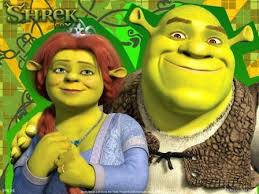
Being green: easier than Kermit said.
In 2009, Disney had their first black princess in The Princess and the Frog’s Princess Tiana. In some ways, Tiana was a throwback to the Cinderella days in that she was not of royal blood and only became a princess through marrying Prince Naveen. However, Tiana’s obsession with hard work and making it on her own was very different to Cinderella’s subservient, gentle spirit in need of rescue. Never once is it implied that Tiana needed Naveen; she was doing fine on her own, even though her life was busy and stressful. Tiana and Naveen came to mutually appreciate each other and fell in love in frog-form, both afraid that they might never be human again. This put their love story on more equal footing, and by the time they become human again, their positions in life are less important than their desire to be their true selves again with each other.
I like to call Naveen “Fun Prince,” because he seems to thrive on music and the social scene, and it was strongly implied that his antics had gotten him into trouble before in the past. He’s like that boy you wanted to date in college who lived in a crap apartment with four other bros and played in a band, but you found out later than his parents own a Fortune 500 company and he’s just been slumming for fun all this time. But like, in a good way, kinda. So even though Tiana gets her royal standing from Naveen, they mutually learn from one another along the way. He teaches her to appreciate things in the moment, and she imparts to him the importance of responsibility. Together, they build a future that contains both.
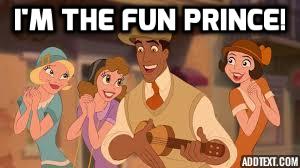
“Anyway, here’s Wonderwall.”
2010’s Tangled is the one that finally hit the mark for me. And, by “hit the mark,” I mean, “had the prince I think is the hottest.” My criteria are not exactly scientific here, as attraction in an imprecise thing at best! But I love the characters of Rapunzel and Flynn/Eugene because of their quirks and flaws and how they learn from each other. Their meet-cute is basically Rapunzel menacing him with a frying pan and making him take her to see some lantern show. Throughout their friendship, he helps Rapunzel realize that being locked away by her “mother” was not okay while giving her life experiences she can treasure, and she’s influencing him into being a better person, actually listening to Eugene instead of falling for the flash and sparkle of Flynn. Without Rapunzel, Flynn has no royal standing, so he and Aladdin have that in common, as well as their pasts as outlaws and thieves. In fact, it’s highly possible that I share Princess Leia’s attraction to slightly reformed scoundrels.

Scruffy-looking nerfherder, class of 2010?
2013’s Frozen follows this dynamic as well, with Anna and Kristoff’s romance. Kristoff is an ice harvester (is that better or worse than being a moisture farmer?) and any future status he might have as a member of the royal family (Anna and Kristoff are not yet married as of the movie’s end) would be from his union with Anna. He will join the proud ranks of Aladdin and Eugene as the commoner princes of Disney. There really should be a short of them getting all excited about the cool stuff in the royal palaces where Aladdin is all, “They have food and a servant just to bathe my pet monkey!” and Kristoff is like, “I guess I don’t have to harvest ice anymore – my wife’s sister is a human ice machine!” and Eugene is like, “My wife totally had magic hair. And also the thread count of these royal sheets? It’s off the charts!” I want to see this happen.
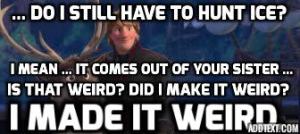
OH JEEZ I’M SO SORRY
So, the progression of the princes is still in progress. This is not a destination, but another stop along a road to greater inclusion and more broken glass ceilings. What could be next? Some things I would like to see in the future are continued efforts to increase diversity, and the possibility of a prince/prince or princess/princess situation instead of the consistently heteronormative pairings we’ve seen since the 30s. I mean, if you hit up the fanfiction, it’s already happening, but even with all this progress, it could be a good while before the studios catch up to what the fans really want to see. In the meantime, there’s always The Road to El Dorado!
Sara Goodwin has a B.A. in Classical Civilization and an M.A. in Library Science from Indiana University. Once she went on an archaeological dig and found awesome ancient stuff. Sara enjoys a smorgasbord of pan-nerd entertainment such as Renaissance faires, anime conventions, steampunk, and science fiction and fantasy conventions. In her free time, she writes things like fairy tale haiku, fantasy novels, and terrible poetry about being stalked by one-eyed opossums. In her other spare time, she sells nerdware as With a Grain of Salt Designs, Tweets, and Tumbls.
—The Mary Sue has a strict comment policy that forbids, but is not limited to, personal insults toward anyone, hate speech, and trolling.—
Follow The Mary Sue on Twitter, Facebook, Tumblr, Pinterest, & Google+.
Have a tip we should know? [email protected]